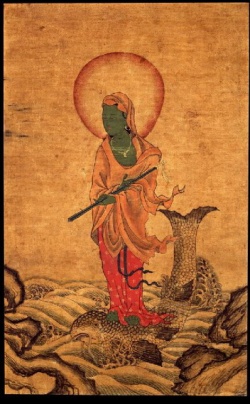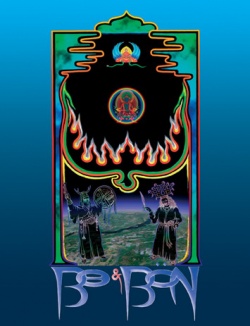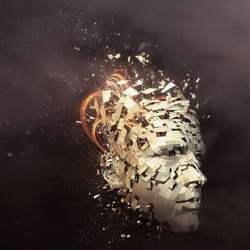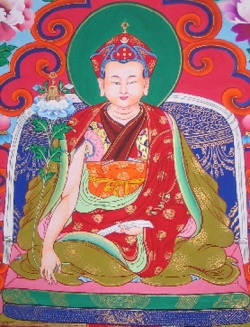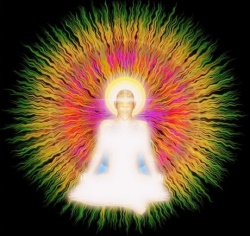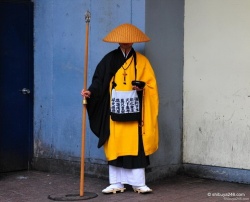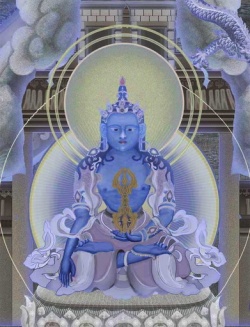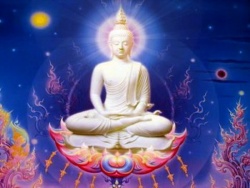The Location of Shambhalla
Although some will make claim that Shambhalla exists only within your heart and mind there are those that would differ.
The idea that Shambhalla is located in the material world is firmly rooted in Tibetan tradition. However the opinions as to its location differ considerably.
Tibetan texts appear to show historical facts about Shambhalla. The data recorded in these texts give names, dates and corresponding events occurring in the outside world. The Hindus and Buddhist alike regard Mount Meru, located in the Himalayas, as the location of Shambhalla. It is the center of the cosmos, having its roots in hell and its summit in heaven.
The mountain peak houses a magnificent central palace radiating a powerful, diamond like light, which is the home of Indra, King of Hindu gods.
Legends tell of her slopes being studded with glittering gemstones and thick with trees heavy with delicious fruit. She is circled by seven rings of golden mountains, each separated from the other by one of seven circular oceans. This entire superstructure rises from an outer ocean, and is flanked by four main continents, each with two subcontinents.
The southern continent, Jambudvipa, corresponds to the physical earth. Each of the other continents represents a nearby planet upon which transmigrating souls following the yellow light-path may be reborn.
Tibetan religious texts tell us that the technology of Shambhalla is supposed to be highly advanced; the palace contains special skylights made of lenses which serve as high-powered telescopes to study extraterrestrial life, and for hundreds of years Shambhalla’s inhabitants have been using aircraft and cars that shuttle through a network of underground tunnels.
On the way to enlightenment, Shambhallans acquire such powers as clairvoyance, the ability to move at great speeds, and the ability to materialize and disappear at will.
Andrew Tomas, author of 'Shambhalla, Oasis of Light', writes,
This remarkable kingdom reputedly exists both above and below ground, with a network of tunnels hundreds of miles long. Cars of strange design flash along their length and they are illumined by a brilliant, artificial light which affords growth to the grains and vegetables and long life without disease to the people.
Hebrew legends speak of a place called Luz which is described as an underground city near a sacred mountain called the 'abode of immortality'.
Some Tibetans think Shambhalla might be in Tibet, perhaps in the Kunlun mountains; others point toward the region around Mongolia and Sinkiang province of China. Others believe it to in Siberia or some other part of Russia. Some lamas claim that it is hidden in the frozen Artic. Others believe Shambhalla only exists in an parallel universe or higher dimension.
In the years between 1923 and 1928, Nicholas Roerich, led an expedition across the Gobi Desert to the Atlai mountain, a journey which covered 15,500 miles across 35 of the world’s highest mountain passes.
It is rumored that he may have been on a mission to find and return what was said to be part of the sacred 'Chintamani Stone,' which was believed to be part of a magical meteorite from the solar system in the constellation of Orion. According to Lamaist legend, a fragment of this stone from what may be the star Sirius, is sent wherever a spiritual mission vital to humanity is set up, and is returned when that mission is completed.
The stone is said possess occult properties, capable of giving telepathic inner guidance and effecting a transformation of consciousness to those in contact with it.
Whether he retrieved the stone or not is not known, but what we do know for certain is that he was sent in search of it by the League of Nations. Just in the fact that he was sent on this expedition lends credibility to the existence of the Shambhalla legends.
Roerich was a man of great creditability.
To his credit, he was a philosopher, author, explorer, member of the Theosophical Society, member of the League of Nations, influential in the FDR administration and was the pivotal force behind placing the Great Seal of the United States on the American dollar. He also produced hundred of paintings capturing the essence of the area and its people.
Roerich strove to link all scientific and creative disciplines to advance true culture and international peace, citing the power of art and beauty to accomplish such a feat. In honor of his efforts, in 1935 The Roerich Peace Pact was established, which obligated nations to respect museums, cathedrals, universities and libraries as they did hospitals, and became part of the United Nations organizational charter.
In his travels through China and Mongolia to the borders of Tibet, Roerich met with a lama that described Shambhalla to him.
According to this famous explorer, Roerich was told,
'Great Shambhalla is far beyond the ocean. It is the mighty heavenly domain. It has nothing to do with our Earth... Only in some places, in the Far North, can you discern the resplendent rays of Shambhala.'
Going on, the lama described it as a 'far-off valley', hidden in the midst of high mountains, with hot springs and rich vegetation.
Then he stated ’ the ruler of Shambhalla is ever vigilant in the cause of mankind. He sees all the events of earth in his 'magic mirror' and 'the might of his thought penetrates into far-off lands'.
Continuing, he goes on to say,
'Uncountable are the inhabitants of Shambhalla. Numerous are the splendid new forces and achievements which are being prepared there for humanity.'
This lama confirmed that messengers from Shambhalla are at work in the world, and that even the ruler of this great kingdom sometimes appears, in a human form, to mankind.
He stressed that the secrets of Shambhalla are well guarded, and that it is impossible for anybody to reach Shambhalla unless their karma is ready and they are called. Although Roerich may have only heard the legend of Shambhalla from the lama, the explorer later went on to report that he discovered a subterranean society of Aghartians.
Aghartians was a civilization of over 20 million people living throughout all the subterranean passages of the world.
According to David Pratt, Mysteries of the Inner Earth, Roerich spent a time examining the inner kingdoms, caverns and empty lava chambers through the studying the local folk lore and talking to those familiar with the area and these legends which included tales of lost tribes and subterranean dwellers. He came to realize that the attributes assigned to the underworld ranged from heavenly to hellish, and its inhabitants from super to sub human.
With all the stories he was able to collect, it came to him that one story seemed quite common. The same story kept surfacing about people abandoning the surface finding refuge in the subterranean world where they found passageways leading to inner earth kingdoms.
Many of these people still live there, coming to the surface rarely.
Great is the belief in the Kingdom of the subterranean people. There is rumored to be a vast underground network of caves and tunnels under the whole of Central Asia, with many passages radiating out from the spiritual hub of Shambhala. According to popular belief, there are numerous secret subterranean passages beneath India, whose entrances are guarded by elementals which assume the shape of rocks or other natural features.
According to H.P Blavatsky, Mesoamerica and South America are honeycombed with long, mysterious tunnels, some of them running for hundreds of miles, from Columbia in the north through Peru and Bolivia to Chile in the south, and to the Amazon jungle in the east. Only a few sections of these tunnels have so far been discovered.
She goes on to say that there is an immense tunnel running from Cuzco to Lima in Peru, and then extending south into Bolivia. In Egypt, a vast subterranean world is traditionally believed to extend from the catacombs of Alexandria to Thebes' Valley of the Kings. The subterranean crypts of Thebes were known as the serpent's catacombs, the serpent representing the ancient wisdom religions.
The Native American believe that their ancestors came out of the earth, after they had taken refuge in caverns to escape past cataclysms. The Cherokee Indians speak of a subterranean world much like our own, with mountains, rivers, trees, and people.
The Aztecs said their ancestors came from a land called Aztlan, and that after escaping its destruction they ended up in a cavern called Chicomoztoc, or the Seven Cavern Cities of Gold, where they lived before emerging to the surface world.
The Mexican demi-god Votan describes a subterranean passage, a 'snake's hole', which runs underground and terminates at the root of the heavens; he himself was allowed to enter it because he was a 'son of the snakes'
The Hopi Indians hold their rituals in an underground chamber known as the kiva in honor of their ancestors life in the inner world. They believe there has been a succession of four worlds. The first world was destroyed by fire, the second by a poleshift, and the third by flooding. Some chosen people were saved from the disasters that destroyed the first two worlds by taking refuge underground, and some survived the destruction of the third world by being sealed inside hollow reeds.
The Pima Indians also speak of the emergence into our world through a spiral hole that was bored up to the earth's surface. Legends of ancestral origins in subterranean lands are also found in Africa and Australia.
Australian aborigines believe their ancestors came up out of the ground, travelled about the country and created new tribes, then,
'ultimately journeyed away beyond the confines of their territory, or went down into the ground again'.
According to the native traditions of the Caroline Islands, Papua New Guinea, and Malaysia, a subterranean race of giants went underground in ancient times.
Once inhabitants of the lost continent of Chamat, they will one day 'emerge and remake the world'. Natives of the Trobiand Islands believe that their ancestors emerged from a subterranean existence through a special hole. Tribes in Bengal and Burma also believe their ancestors emerged from a subterranean world.
Hitler also made attempts to locate and enter the gates of Shambhalla... The idea of Shambhalla and its occult knowledge was an obsession to him. The roots of his occult desires can be traced far back into his youth where he studied the occult and yoga in Vienna. The young Hitler received initiation into the American Indian Peyote Cult.
After he was introduced to The Secret Doctrine, he then turned his attention more to Theosophy. Later he joined the occult group in Germany called Ultima Thule, out of which the Nazi Party was born.
Upon assuming power, Hitler established the ministry of Ancestral Memories, headed by the Chairman of the Sanskrit Department at Munich University.
Through this connection with Sanskrit studies, the Nazis adopted the swastika, an ancient symbol of good luck and well being. Although many believe that Hitler designed this emblem it is a fact that the Hindu, Buddhist and Jain worlds had honored this symbol for thousands of years prior to the Nazi movement.
With the help of the explorer Sven Hedlin, Hitler sent several expeditions to Tibet. The Nazis claimed that although Shambhalla was inaccessible to them, they also made contact and gained help from the mystical kingdom of Agartha. It was reported that the leaders held a ceremony led by a man with the keys to Argatha.
The Theosophists Society believes Shambhalla to be the seat for the Brotherhood of Adepts. Shambhalla sends forth messengers and teachers to work among mankind for the advancement of spiritual growth.
Surrounded by an akashic veil, the theosophists claim it has several locations here on earth. One location is 'situated in the highlands of Asia, somewhere to the westward of the meridian line passing through Lhassa'. Long ago, this locality was a sacred island in a vast Central Asian inland sea, known as the 'abyss of learning' or 'sea of knowledge', and was accessible via subterranean passages. According to tradition, this place exists to this day as an oasis surrounded by the Gobi desert.
The second location is Mount Meru or Sumeru. It is the north pole of the earth, so chosen not for its geographical qualities, but because of its astrological position. It is the mystical north pole, geographically identical with the north pole of the earth, but mystically quite different.
Theosophical literature also states that there is an even higher Shambhala located in the sun, and that all these different localities are inhabited by classes of entities with which the human race is spiritually and intellectually interconnected.
In Hindu mythology Meru is the mystical mountain at the center of the world, where Indra, king of the gods, resides. However, so as not to get confused, Meru actually has several different meanings, including a Mount Meru in Asia, the north geographical pole, the north celestial pole, the earth's spin axis, the world axis connecting earth to higher realms, and the cerebrospinal axis of the human body... The Egyptians, Akkadians and Indians also believe that Meru has its opposite.
The Artic Meru, known as Sumeru, is the dwelling place of the gods and the Antartic Meru, known as Kumeru is the dwelling place of demons.
Meru, the Olympus of the Indians, is said to be situated in the center of the earth. It is guarded by serpents, which 'watched the entrance to the realm of Secret Knowledge'. It is the 'land of bliss' of the earliest Vedic times.
Occult teachings 'place it in the very center of the North Pole, pointing it out as the site of the first continent on our earth, after the solidification of the globe. In the ancient astronomical text Surya-Siddhanta, Meru is described as,
'passing through the middle of the earth-globe, and protruding on either side.'
That other side, the Southwestern American Hopi Indians believe is their sacred Black Mesa.
H.P. Blavatsky says that Meru is not,
"the fabulous mountain in the navel or center of the earth,"
...but its roots and foundations are in that navel, though it is in the far north itself. This connects it with the "central" land "that never perishes."
She continues,
'According to Tibetan tradition the White Island is the only locality which escapes the general fate of other dwipas and can be destroyed by neither fire nor water, for - it is the "eternal land"'
The earth is powered by a life source giving off electro-magnetic energy.
This energy (blood of mother earth) is distributed through the body through veins which we call ley lines, giving life to everything. The heart which pumps the blood is found in the 'centre' or 'navel' of the earth...
The Caretaker of Earth, Shambhalla, has been described as a main power center with auxiliary centers scattered about the globe, linked by subterranean passageways. Unknown to the surface people lives humans that the 'gods' created.
According to the Chaldean Account of Genesis.
’Human beings... the great gods created, and in the earth the gods created for them a dwelling. In the midst of the earth they grew up and became great, and increased in number, Seven kings, brothers of the same family...'
Iranian, Indian, Chinese, Scandinavian, Native American Indian, Mayan and Aztec literature also make references to Inner Earth civilizations of Shambhalla.
The Japanese also have a Shambhalla which they have named ‘Island of the Congealed Drop’. It is situated ‘on the top of the globe' but at the same time 'at the center of the earth'. Its first roof-pillar was the earth's axis, and over it was the pivot of the vault of heaven.
The Chinese actually describe their idea of Shambhalla as the Center of the Earth, directly under Shang-te's heavenly palace, declaring it to be in the polestar. They also call it, ‘The Palace of the Center’.
The Egyptians located their Ta Neter, or Land of the Gods, in the extreme North.
Let’s take into consideration the Legend of Santa Claus or Saint Nick. Although long forgotten the reasoning behind it, our children still send letters to Santa addressed to the North Pole.
North of the Himalayas is a version of Shambhalla, Uttarakuru or northern Kuru.
It is described as the blissful land of the sages towards which Arjuna, the warrior prince of the Bhagavad-Gita, travelled in search of enlightenment. Magic fruit trees yielded the nectar of immortality. It is one of four regions surrounding Mount Meru and is the homeland of the Siddhas, enlightened yogis famed for their miraculous powers.
Greek mythology has their own version of Shambhala as well. Greek mythology introduces us to what is known as Hyperborean Land. The land of eternal summer and favorite home of Apollo..
According to the Orphics, the Island of Electris, the seat of the gods, lies under the polestar in the furthest waters of Tethys.
The Mandean Gnostics believed that an ideal earth with eternal light was the home of a divine race of super humans. This was reported to be located in the North, separated from our world by a high mountain of Ice.
The Avestan term 'Airyanem Vaejah' designates the cradle land of the Aryan-Iranians. It supposed to be located not in any of the earth's seven climates, but at the center of the central zone, the eighth climate.
It was there that the 'first man', received the command to construct a vara, or enclosure, where the most highly developed humans, animals, and plants would be gathered in order to save them from the deadly winter unleashed by the demonic powers (nuclear winter brought on by atomic warfare) so that they might one day rebuild the world.
This vara or paradise had a gate and luminescent windows which secreted an inner light within. It was illuminated by both uncreated and created lights.
This vara in most likelihood is a space craft.
